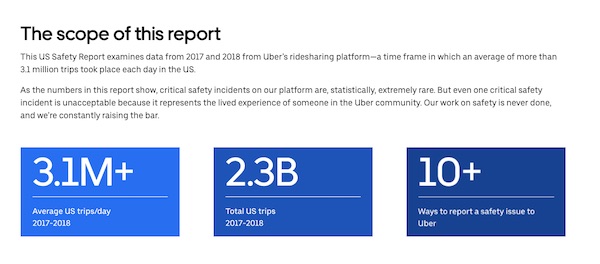After 5,981 sexual assaults, is Uber safe? Look deeper . . .

Uber released its safety report for the years 2017 and 2018 for the US. It documents 5,981 sexual assaults. Ergo, Uber is a menace, right?
Before you read on, please know that I consider sexual assault to be evil and awful. Anyone who commits one should be punished and, to the extent possible, prevented from being in a position to repeat what they did. I have close friends who have been victims of assault, and I’ve seen the struggle they face. If you read what I’ve written here and assume that I’m somehow tolerant of assault, you’ve missed the point.
Furthermore, I have been a consistent critic of Uber, which has historically had a toxic and unethical culture. Uber appears to be improving, but it has a long way to go.
But data is data. So let’s look at the data in this Uber Safety Report and see what we can learn from it — in the hopes that we can reduce and prevent more assaults in the future.
Is 6,000 sexual assaults a lot?
Of course it is. That’s a lot of victims.
So what are the chances of an assault in an Uber ride?
Well, there were 2.3 billion Uber rides in the US in the two years that this report covers. So, doing the math, your chances of being in an Uber ride with an assault are 0.0003%. Putting it another way, that’s one assault in every 385,000 rides.
In 42% of those assaults, drivers were the victims. This is still awful for those Uber drivers, but if you’re a rider, that means your odds of being assaulted are more like one in 900,000. You’re probably more likely to get run over crossing the street than to get assaulted in an Uber.
All assaults are terrible, but not all assaults are equivalent. Most of the assaults were attempts at non-consensual kissing. The odds of attempted penetrative sex were 1 in 4 million rides, and of actual penetrative rape were 1 in 5 million rides.
There are about 735,000 sexual offenses reported in the US every year. Does this mean that one out of 122 sexual assaults occur in an Uber? That would be horrifying, but it’s almost certainly wrong. I’m sure there’s a lot higher chance of reporting an assault to Uber than there is of reporting an assault to the police and starting a criminal proceeding.
If you need a ride, are you safer in an Uber, a taxi, or some other form of transportation? There’s no way to know this, since there is no consistent reporting of assaults in taxis or on public transportation. But the reporting from Uber certainly contains no evidence that a taxi ride would be safer.
Data is better than no data. And because Uber is a centralized resource, it can actually work to improve safety in the rides it facilitates. Uber now requires background checks for all drivers. A background check is not going to catch a driver who is a creep that’s never been reported before. However, this means that Uber drivers are on par with taxi drivers — they’ve been checked. When there are complaints, Uber investigates and potentially bans drivers, although that process isn’t as good as it ought to be.
In the future, Uber could require video recording in all vehicles. That would reduce the chances of assault significantly.
Reporting is good, even if the numbers are shocking
Uber needs to do better, not just on the issue of assaults, but in general. Improving the culture of a company this large is a very long, slow process.
But the company has reported these numbers, even though they are going to shock people. Now we can ask more questions. Will video recording reduce assaults? We could test that. Are background checks effective? We could test that. Is a focus on enforcement and banning drivers accused of assault the solution? We could test that, too. Uber has added safety features to its app, and should certainly consider adding more.
Every one of these assaults is horrible. Every one is going to mess up somebody’s life to one extent or another.
But the evidence in this report does not show that Uber is unsafe. It shows that the odds of getting assaulted in a Uber are low, and that since Uber is tracking the assaults, that we can reduce those odds. And we can hold Uber accountable.
If you think 6,000 assaults are horrifying, I can’t argue with you. But if you think banning Uber is the right response, you’re ignoring the evidence.
If you’ve got a better idea, I’m all ears.
Personally I find taxis much more dangerous since in most places they have none of the features such as GPS tracking and even reviews that are built into apps like Uber and Lyft. We don’t have ridesharing here in Vancouver yet and I will not get into a taxi unless I absolutely have to – assaults and ride refusals seem to be rampant according to the media, and the quality of driving is – well, nothing short of terrifying. And the taxi companies certainly aren’t going to release a safety report to the public to help us be better informed.
Thanks for the clear analysis, Josh. NPR covered Uber’s report this morning (https://www.npr.org/2019/12/05/785037245/uber-received-nearly-6-000-u-s-sexual-assault-claims-in-past-2-years), and they made the same points as you did here about the number of assaults compared to the number of rides and about our inability to compare Uber’s record to that of other public ride service.
I’m speculating, but chances sre that Über rides is the area with the least _*unreported*_ cases of sexual assault. That would make these data even more exceptional, if true. The majority of sexual assault are probably never reported, so we truly don’t know the full volume of the problem.